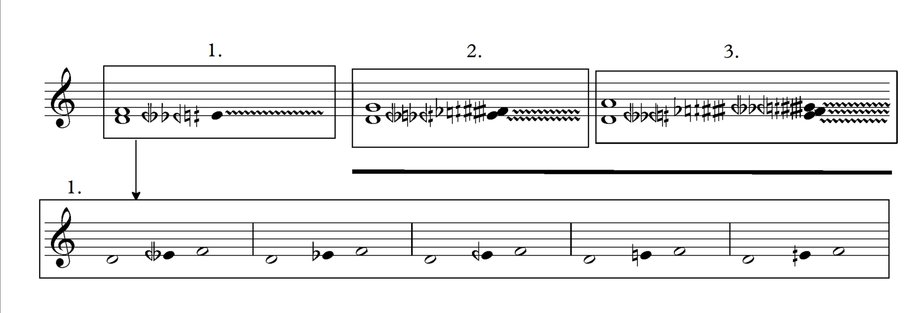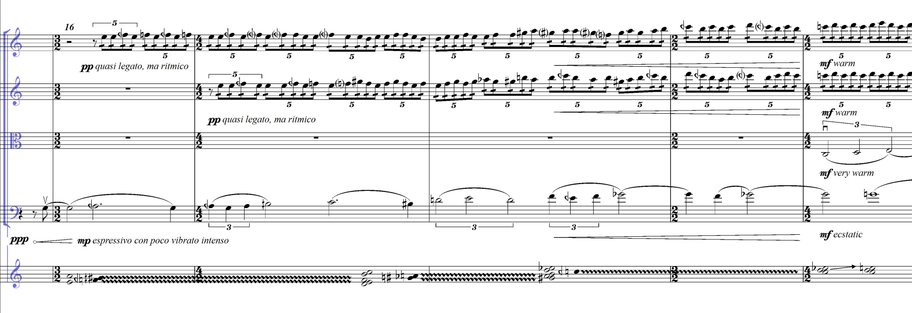Figure 24: String Quartet No.1, bars 16-20, with pitch reduction at the bottom stave.
The pivotal degrees are designated by white noteheads, the fluctuating ones – by black noteheads. The alterations employed are given for each fluctuating degree. (Definition for Fluctuation is available in Chapter 1.2.)
NB: In this example I have respelled some accidentals back to their original instances (which were respelled in the score for players’ convenience at a later stage) to give the original harmonic structure, as initially composed.
____________________________________________
In this passage the harmony, as determined by the background morphomodal network (bottom stave) and its interaction with the foreground mophopolyphonic texture, develops without fixed boundaries being perceived between microtonal and semitonal harmonies. The passage develops further (after bar 20) in entirely semitonal harmonies, while the development of texture and line continues unbroken.
Another instance where a predominantly microtonal harmony morphs gradually into predominantly semitonal is in bars 157-161 (Example 23 (starts at b.121)). The whole section before that moment has been developed in predominantly microtonal harmonies, whereas the section that follows is semitonal.
The section in bb.140-166 (Example 23 (starts at b.121)) deserves particular attention. It is developed in a rather narrow pitch range, within a fifth (with only few exceptions) and around an Ison drone, initially on g, then shifting to b and c. The rhythm is deliberately monotonous and the structure of the motifs in the melodic lines is quite simple and repetitive. This conveys a hypnotic, relentless, quasi-ritual quality, while the main factor that introduces a great variability to the overall monotony of rhythm and motivic structure is namely the harmony, more precisely the microtonal harmonies (developed with the same morphomodal method) which explore a great variety of microtonal modal colour in this very narrow pitch range.
This passage has been inspired by a particular type of chants that are sung only once a year, at the Lamentation at the Tomb (Опело Христово) service at the evening on Good Friday.140 (click) These chants are composed of brief and simple motifs that are repeated antiphonally over very long texts and create a very particular atmosphere. It is this atmosphere that is the main inspiration for this passage in my quartet, as it has little resemblance to the chants in its pitch material and in the way it sounds.
It could be said in general that despite the profound and holistic influence that Eastern Chant has exerted on my style and technique, my music only seldom resembles chant melodies and sonorities directly. There are certain intonations from Eastern Chant that are integrated in the fabric of my music as a vocabulary, but I have generally not been trying to recreate or imitate the surface structures and lines of the Chant tradition, except for the very special moments when I have been explicitly aiming to refer to its atmosphere, such as the aforementioned passage from the String Quartet, the string passage in The Sacred Flight – figures J-L (Example 22) or the very beginning of Scene 5 in The Mirror (Example 24). However, in these passages the Chant tradition is not quoted or imitated, but its essence re-created and interpreted.
There are only few examples of micro-quotations from chants and most of them appear in the String Quartet: bars 180-182 (Example 23 (starts at b.121)) and 194-196 (Example 23), while the passage in bb. 208-215 (Example 23), although closely resembling a chant, is not a quotation. The only two other instances of Chant quotation in this thesis are in the 3rd Percussion Concerto, bb. 179-184 (Example 25); and in the last of the 7 Pieces from the Temple for Piano solo (not included with the thesis) (Example 26). In A Seasong, a chant motive is developed exegetically in a way that makes it impossible to recognise aurally.



